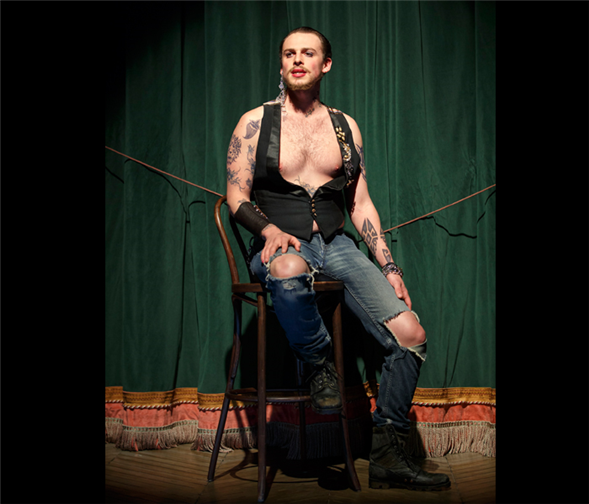Translate Page

A new play lives in the modern gay moment
---
10 years ago, Christopher Sears's character in Gently Down the Stream might've seemed impossibly fictional. An openly gay, tattoo-covered performance artist named Harry, he not only embraces the elasticity of unconventional relationships, but also craves the domesticity of raising a child. He wants to live both inside and outside the lines, and he doesn't see that as a contradiction. 10 years ago, he might've been understood as a dramatist's fantasy for the type of queer life that the larger culture would never make room for.
But now is not then. Today -- in a world of legalized gay marriage, increasingly regular gay parenting, and the mainstream influence of radical queer artists like Lisa Kron, Taylor Mac, and Justin Vivian Bond -- Harry seems like a guy you might meet at a parent-teacher night.
That's why he's so necessary in Martin Sherman's play, which is now at the Public Theater. True, the central character is Beauregard (Harvey Fierstein), an aging musician who lives in London and has witnessed decades of homophobia. (He even saw the fire at the UpStairs Lounge, which is also the subject of a new musical). Just as he's ready to disappear into his final, bitter years, however, Beau stumbles into a love affair with Rufus (Gabriel Ebert), a much younger man who has no problem believing that gay people can and should be happy. As they teach other things about the world, these men from two generations also articulate a bold hope for the gay future.
Harry's arrival suggests the future isn't so far away. "The cool thing about him is that he has his own trajectory," says Sears. "Harry looks like he could be a performance artist, but performance artists 'don't have children.' Or if they do, they don't look like that. Or if they're gay, they dress in a certain way, but not like Harry. I love how Martin and [director] Sean [Mathias] and Harvey are working to redefine expectations."
We can even see that stance in Harry's costumes, which are designed by Michael Krass. Originally, Sears says, Harry was going to have a much wilder look, particular during a scene where he stands alone on stage, performing the classic Gershwin tune "The Man I Love" as part of his act. "Originally, they wanted it to be more of an avant garde costume," the actor explains. "I think it's originally written that he's in a tuxedo, but half-naked. And then we played around with some drag. But we settled on the vest with no shirt underneath, so you can see the tattoos, and the same pants he wears in other scenes.
"The idea [of this costume choice] is that he can keep his center. You don't need to moonlight as another character to be free."
That freedom also matters when Harry appears in a wedding scene. As he and the other characters stand before us, present at this meaningful ritual without having to change themselves, the show reaches an emotional peak. "Sean originally had the idea that Harvey would be out there by himself," Sears recalls. "But then he brought us out there, and that's been really cool. You can feel it affecting people. The energy is like it would be in a wedding. It feels real."
---
Follow TDF Stages editor Mark Blankenship at @IAmBlankenship. Follow TDF at @TDFNYC.
Photos by Joan Marcus. Top photo: Christopher Sears in the "Man I Love" scene.
TDF Members: Go here to browse our current discounts for theatre, dance, and concerts.